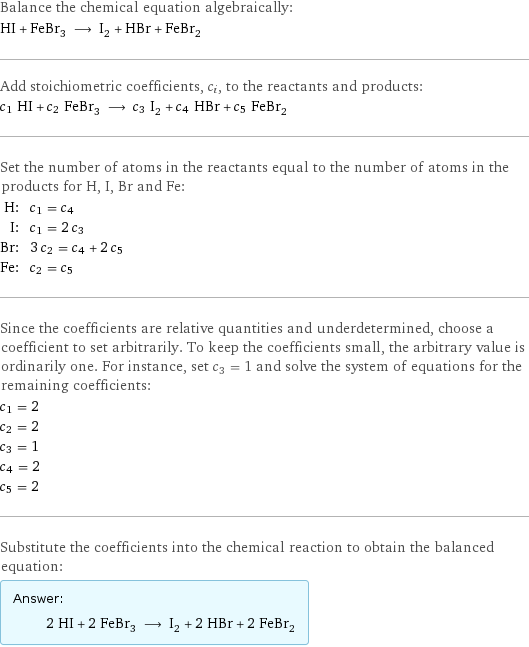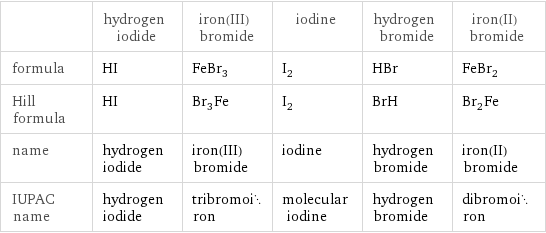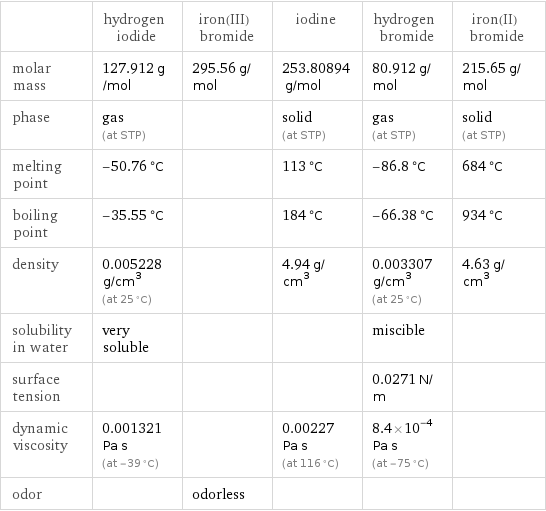Input interpretation

HI hydrogen iodide + FeBr_3 iron(III) bromide ⟶ I_2 iodine + HBr hydrogen bromide + FeBr_2 iron(II) bromide
Balanced equation

Balance the chemical equation algebraically: HI + FeBr_3 ⟶ I_2 + HBr + FeBr_2 Add stoichiometric coefficients, c_i, to the reactants and products: c_1 HI + c_2 FeBr_3 ⟶ c_3 I_2 + c_4 HBr + c_5 FeBr_2 Set the number of atoms in the reactants equal to the number of atoms in the products for H, I, Br and Fe: H: | c_1 = c_4 I: | c_1 = 2 c_3 Br: | 3 c_2 = c_4 + 2 c_5 Fe: | c_2 = c_5 Since the coefficients are relative quantities and underdetermined, choose a coefficient to set arbitrarily. To keep the coefficients small, the arbitrary value is ordinarily one. For instance, set c_3 = 1 and solve the system of equations for the remaining coefficients: c_1 = 2 c_2 = 2 c_3 = 1 c_4 = 2 c_5 = 2 Substitute the coefficients into the chemical reaction to obtain the balanced equation: Answer: | | 2 HI + 2 FeBr_3 ⟶ I_2 + 2 HBr + 2 FeBr_2
Structures

+ ⟶ + +
Names

hydrogen iodide + iron(III) bromide ⟶ iodine + hydrogen bromide + iron(II) bromide
Equilibrium constant
![Construct the equilibrium constant, K, expression for: HI + FeBr_3 ⟶ I_2 + HBr + FeBr_2 Plan: • Balance the chemical equation. • Determine the stoichiometric numbers. • Assemble the activity expression for each chemical species. • Use the activity expressions to build the equilibrium constant expression. Write the balanced chemical equation: 2 HI + 2 FeBr_3 ⟶ I_2 + 2 HBr + 2 FeBr_2 Assign stoichiometric numbers, ν_i, using the stoichiometric coefficients, c_i, from the balanced chemical equation in the following manner: ν_i = -c_i for reactants and ν_i = c_i for products: chemical species | c_i | ν_i HI | 2 | -2 FeBr_3 | 2 | -2 I_2 | 1 | 1 HBr | 2 | 2 FeBr_2 | 2 | 2 Assemble the activity expressions accounting for the state of matter and ν_i: chemical species | c_i | ν_i | activity expression HI | 2 | -2 | ([HI])^(-2) FeBr_3 | 2 | -2 | ([FeBr3])^(-2) I_2 | 1 | 1 | [I2] HBr | 2 | 2 | ([HBr])^2 FeBr_2 | 2 | 2 | ([FeBr2])^2 The equilibrium constant symbol in the concentration basis is: K_c Mulitply the activity expressions to arrive at the K_c expression: Answer: | | K_c = ([HI])^(-2) ([FeBr3])^(-2) [I2] ([HBr])^2 ([FeBr2])^2 = ([I2] ([HBr])^2 ([FeBr2])^2)/(([HI])^2 ([FeBr3])^2)](../image_source/f3fb293adde4d7962f8e1c183aa367e3.png)
Construct the equilibrium constant, K, expression for: HI + FeBr_3 ⟶ I_2 + HBr + FeBr_2 Plan: • Balance the chemical equation. • Determine the stoichiometric numbers. • Assemble the activity expression for each chemical species. • Use the activity expressions to build the equilibrium constant expression. Write the balanced chemical equation: 2 HI + 2 FeBr_3 ⟶ I_2 + 2 HBr + 2 FeBr_2 Assign stoichiometric numbers, ν_i, using the stoichiometric coefficients, c_i, from the balanced chemical equation in the following manner: ν_i = -c_i for reactants and ν_i = c_i for products: chemical species | c_i | ν_i HI | 2 | -2 FeBr_3 | 2 | -2 I_2 | 1 | 1 HBr | 2 | 2 FeBr_2 | 2 | 2 Assemble the activity expressions accounting for the state of matter and ν_i: chemical species | c_i | ν_i | activity expression HI | 2 | -2 | ([HI])^(-2) FeBr_3 | 2 | -2 | ([FeBr3])^(-2) I_2 | 1 | 1 | [I2] HBr | 2 | 2 | ([HBr])^2 FeBr_2 | 2 | 2 | ([FeBr2])^2 The equilibrium constant symbol in the concentration basis is: K_c Mulitply the activity expressions to arrive at the K_c expression: Answer: | | K_c = ([HI])^(-2) ([FeBr3])^(-2) [I2] ([HBr])^2 ([FeBr2])^2 = ([I2] ([HBr])^2 ([FeBr2])^2)/(([HI])^2 ([FeBr3])^2)
Rate of reaction
![Construct the rate of reaction expression for: HI + FeBr_3 ⟶ I_2 + HBr + FeBr_2 Plan: • Balance the chemical equation. • Determine the stoichiometric numbers. • Assemble the rate term for each chemical species. • Write the rate of reaction expression. Write the balanced chemical equation: 2 HI + 2 FeBr_3 ⟶ I_2 + 2 HBr + 2 FeBr_2 Assign stoichiometric numbers, ν_i, using the stoichiometric coefficients, c_i, from the balanced chemical equation in the following manner: ν_i = -c_i for reactants and ν_i = c_i for products: chemical species | c_i | ν_i HI | 2 | -2 FeBr_3 | 2 | -2 I_2 | 1 | 1 HBr | 2 | 2 FeBr_2 | 2 | 2 The rate term for each chemical species, B_i, is 1/ν_i(Δ[B_i])/(Δt) where [B_i] is the amount concentration and t is time: chemical species | c_i | ν_i | rate term HI | 2 | -2 | -1/2 (Δ[HI])/(Δt) FeBr_3 | 2 | -2 | -1/2 (Δ[FeBr3])/(Δt) I_2 | 1 | 1 | (Δ[I2])/(Δt) HBr | 2 | 2 | 1/2 (Δ[HBr])/(Δt) FeBr_2 | 2 | 2 | 1/2 (Δ[FeBr2])/(Δt) (for infinitesimal rate of change, replace Δ with d) Set the rate terms equal to each other to arrive at the rate expression: Answer: | | rate = -1/2 (Δ[HI])/(Δt) = -1/2 (Δ[FeBr3])/(Δt) = (Δ[I2])/(Δt) = 1/2 (Δ[HBr])/(Δt) = 1/2 (Δ[FeBr2])/(Δt) (assuming constant volume and no accumulation of intermediates or side products)](../image_source/8960312038371a822d85e1df1df84967.png)
Construct the rate of reaction expression for: HI + FeBr_3 ⟶ I_2 + HBr + FeBr_2 Plan: • Balance the chemical equation. • Determine the stoichiometric numbers. • Assemble the rate term for each chemical species. • Write the rate of reaction expression. Write the balanced chemical equation: 2 HI + 2 FeBr_3 ⟶ I_2 + 2 HBr + 2 FeBr_2 Assign stoichiometric numbers, ν_i, using the stoichiometric coefficients, c_i, from the balanced chemical equation in the following manner: ν_i = -c_i for reactants and ν_i = c_i for products: chemical species | c_i | ν_i HI | 2 | -2 FeBr_3 | 2 | -2 I_2 | 1 | 1 HBr | 2 | 2 FeBr_2 | 2 | 2 The rate term for each chemical species, B_i, is 1/ν_i(Δ[B_i])/(Δt) where [B_i] is the amount concentration and t is time: chemical species | c_i | ν_i | rate term HI | 2 | -2 | -1/2 (Δ[HI])/(Δt) FeBr_3 | 2 | -2 | -1/2 (Δ[FeBr3])/(Δt) I_2 | 1 | 1 | (Δ[I2])/(Δt) HBr | 2 | 2 | 1/2 (Δ[HBr])/(Δt) FeBr_2 | 2 | 2 | 1/2 (Δ[FeBr2])/(Δt) (for infinitesimal rate of change, replace Δ with d) Set the rate terms equal to each other to arrive at the rate expression: Answer: | | rate = -1/2 (Δ[HI])/(Δt) = -1/2 (Δ[FeBr3])/(Δt) = (Δ[I2])/(Δt) = 1/2 (Δ[HBr])/(Δt) = 1/2 (Δ[FeBr2])/(Δt) (assuming constant volume and no accumulation of intermediates or side products)
Chemical names and formulas

| hydrogen iodide | iron(III) bromide | iodine | hydrogen bromide | iron(II) bromide formula | HI | FeBr_3 | I_2 | HBr | FeBr_2 Hill formula | HI | Br_3Fe | I_2 | BrH | Br_2Fe name | hydrogen iodide | iron(III) bromide | iodine | hydrogen bromide | iron(II) bromide IUPAC name | hydrogen iodide | tribromoiron | molecular iodine | hydrogen bromide | dibromoiron
Substance properties

| hydrogen iodide | iron(III) bromide | iodine | hydrogen bromide | iron(II) bromide molar mass | 127.912 g/mol | 295.56 g/mol | 253.80894 g/mol | 80.912 g/mol | 215.65 g/mol phase | gas (at STP) | | solid (at STP) | gas (at STP) | solid (at STP) melting point | -50.76 °C | | 113 °C | -86.8 °C | 684 °C boiling point | -35.55 °C | | 184 °C | -66.38 °C | 934 °C density | 0.005228 g/cm^3 (at 25 °C) | | 4.94 g/cm^3 | 0.003307 g/cm^3 (at 25 °C) | 4.63 g/cm^3 solubility in water | very soluble | | | miscible | surface tension | | | | 0.0271 N/m | dynamic viscosity | 0.001321 Pa s (at -39 °C) | | 0.00227 Pa s (at 116 °C) | 8.4×10^-4 Pa s (at -75 °C) | odor | | odorless | | |
Units
